When love is not enough
Foreign orphans have flowed into American homes over the past decade, each clutching the dreams of the adoptive family. But not everyone lives happily ever after. Sometimes, the children are simply broken.
But there is hope. In TCU’s psychology department, researchers are fast becoming national leaders in understanding how to repair these precious lives.
When love is not enough
Foreign orphans have flowed into American homes over the past decade, each clutching the dreams of the adoptive family. But not everyone lives happily ever after. Sometimes, the children are simply broken.
But there is hope. In TCU’s psychology department, researchers are fast becoming national leaders in understanding how to repair these precious lives.
No baby-blue book records Dmitri White’s earliest years. If it did, there would be only a few terse sentences — abandoned at birth, 15-year-old mother — and a few gray photos, one of his arrival, one of his departure, one of a slight boy who mysteriously earned Dmitri’s affection. Maybe someone noticed when he first stood up. Maybe they applauded his first word.
Probably not.
Once upon a time came and went for Mike ’80 and Carol White in 1998. The couple’s life was all-American before that: They fell in love, married and welcomed Chris, now 14, and Lauren, 7, into their family. Mike’s obstetrical practice flourished while Carol retired from nursing to open a successful children’s clothing boutique, and the family lived a well-ordered life in a two-story house, complete with backyard pool and weekend cottage. Happy. Idyllic.
Deciding to share that with an abandoned child wasn’t hard for the family; adopting would be “the right thing to do for the planet.”
Mike compares Dmitri’s arrival that year with D-Day. “We had a family before he walked in, and we have a family after,” Mike said. “He caused the death of the first family.”
|
Looking for his future. After a year in his new home, Dmitri, right, still isolated himself emotionally from the family. |
 |
The first sign was the vomiting. Violent, debilitating heaves and loss of muscle control from motion sickness that began within a block of the Russian baby house. Then the psychotic behavior on the plane, a ride Carol wryly said “lasted at least one thousand, seven hundred hours.” Besides destroying everything his 3-year-old hands grasped and not sleeping during the 24-hour trip, Dmitri went into a rage if his new parents made eye contact with him. At one point, he struck Carol in the face with such force it knocked the earrings from her ears.
Worried they would be ejected from the plane in Atlanta, Carol finally locked herself in the bathroom with this hysterical child who did not speak her language and would not stop screaming.
“He saw me in the mirror and started in again, so I put the toilet lid down and sat with my head between my knees so he didn’t have to look at me in the mirror,” she said. “I stayed in there for an hour and a half trying to get him under control and just give everyone else a break.”
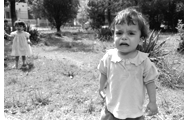 |
No one notices. The children in foreign orphanages, like the Romanian youngsters pictured here, are surrounded by people, yet seem all alone. |
![]()
Shortly after arriving at his new home, Dmitri’s night terror began. He tore all the wallpaper off the walls in his room and began stalking about the house when the others slept. To protect them all, Mike stacked chairs and furniture around Dmitri’s door so the noise of any movement would waken them. One night Dmitri pushed and wedged himself between a desk and the doorway until he had bruises on his back and blood on his face because he was so determined to get out, Mike said.
“It didn’t matter what he had to go through, even self-mutilation, if that’s what he wanted, that’s what he was going to do,” he said.
“What did I think then? I kept remembering that the adoption was final, and unfortunately the parents were not going to come rescind it.”
But when Dmitri impaled a fork deep into his new brother’s arm over food and then jerked a quarter-sized patch of hair from Lauren’s head for no reason, the Whites knew: “Saving” Dmitri from the horror of a Russian orphanage might just cost them their family.
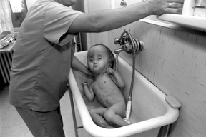 |
Hard lives. Baths are a daily activity, but medical care is behind the time, as evidenced by the two children in the Romanian orphanage with hydrocephalus (water on the brain). A simple operation has successfully treated that condition in the United States for 50 years. |
![]()
Thousands of American families would nod knowing heads at that statement. Since the early 1990s, Americans wanting children have flocked to foreign countries; U.S. laws that favor the rights of the birth parents have frightened many prospective adoptive couples who don’t want the adoptions reneged several years later. When orphanage doors flew open in Eastern Europe and Asia a decade ago, American couples spent life savings to bring the children out.
Overseas adoptions have more than doubled in the past eight years, leaping from 7,088 international orphans coming to the U. S. in 1990 to 15,774 in 1998.1 At the beginning of the decade, not one child was adopted from Russia or China. By 1998 those two countries led the list with about 9,000 children (combined) coming to American homes.
Once the children got home, the problems erupted — belligerent, unmanageable behavior, stealing, lying, violence. The startled parents turned to professionals who told them to be patient, these kids only needed lots of love.
Wrong.
![]()
| The cleanliness of the orphanage surprised the Whites. Immaculate, they said. Sterile. Fresh paint throughout covered the crumbling façade, toys sent by kind hearts were in pristine condition — still in their wrappers and displayed about the building in glass cases. Museum-like. Untouchable. | 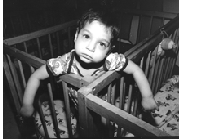 |
![]()
The children, infants to age 4, slept like Snow White’s dwarfs in rows of tiny beds and cribs. Workers seemed abundant, but when the Whites were finally allowed, at some insistence, to see Dmitri’s world, the caregivers seemed to care little, mostly standing around, chatting while the children muddled aimlessly about in an adjacent room. On the surface, the place wasn’t as awful as the Whites expected. Not like the squalid Romanian orphanages they had seen on TV.
But then, it has been almost 10 years since the world was shown the horrors of Eastern Bloc orphanages.
![]()
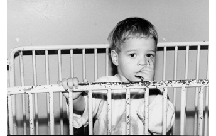 |
When photographer Kathryn Kuzmich ’93 arrived in Romania this summer to chronicle life in the baby houses, she too was surprised that the orphanage was as well stocked as it was. The hospital was another story. When she walked in to one sweltering room of sick babies, she couldn’t help but notice husky little Mihai staring from an iron crib. |
![]()
Kuzmich stared back, smitten by the blond little boy with the sad brown eyes. This was Kuzmich’s third visit to Eastern European orphanages. But even after seeing hundreds of warehoused children, her heart felt a special ache for the suffering of Mihai and his roommates. She knew the hospital stay was just new misery to already gloomy lives.
At the orphanage, they at least had toys and someone wandering through regularly to check on their safety. At the hospital, an infant could easily choke on formula gushing from the large hole in the propped bottle or fall from the decrepit cribs. And no one would notice. At least not in time.
The orphanage in Slatina where 18-month-old Mihai lives is called Prichindel, an affectionate term for a little child. It hides behind an overgrown fence on a moderately busy street corner, right across from a military compound. Up a couple of chipped cement steps, behind a crusty metal gate and sagging chain-link fence, past emaciated roses twining upward on rusted barbed wire, live nearly 150 people, all under the age of 3.
Prichindel has received foreign aid for the past few years that has improved the care and conditions for the children. It is among the better of poor institutions in that country. Workers there are expected to hold infants during feedings, to interact with the children during play. There is an abundance of toys and clothing, better food and medical care than others. At first glance, like Dmitri’s first home, this orphanage seems clean and orderly — for the most part. It doesn’t “look” so bad.
Until you notice what isn’t there.
![]()
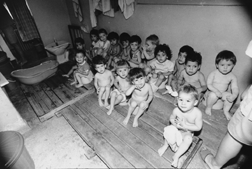 Potty time. Most of the bathrooms in this Romanian orphanage have been renovated by HUG, a Dallas charity, but the old ones, right, feature broken or missing plumbing. When HUG workers first arrived they were nearly overcome by a horrific smell. They soon discovered the building sat on six inches of raw sewage because the pipe from the orphanage to the city sewers was broken. HUG raised $3,000 to repair it and later renovated most of the plumbing and wiring, including the installation of central heat, which also gives them a constant supply of hot water, a luxury for most of the country.
Potty time. Most of the bathrooms in this Romanian orphanage have been renovated by HUG, a Dallas charity, but the old ones, right, feature broken or missing plumbing. When HUG workers first arrived they were nearly overcome by a horrific smell. They soon discovered the building sat on six inches of raw sewage because the pipe from the orphanage to the city sewers was broken. HUG raised $3,000 to repair it and later renovated most of the plumbing and wiring, including the installation of central heat, which also gives them a constant supply of hot water, a luxury for most of the country.
![]()
No one has to tell a new mother to pick up a crying infant. Or explain the gentle rock that soothes a child. Every father instinctively tosses his little one toward the sky to elicit surprised giggles.
Ground-breaking research with British war orphans in the 1940s was the first clue that such child’s play was immensely essential, said Karyn Purvis, a TCU psychology researcher and doctoral student. These studies proved that babies needed more than food and shelter. Without love and attention, children could not develop into functional adults.
The problems neglected or abused children face now have names — sensory integration and attachment disorders — and are the focus of Purvis’ work.
Just as lack of nutrition causes severe physical disorders, lack of sensory stimulation during early years produces emotionally and mentally dysfunctional people. Human brain development is directly tied to the input we receive through our senses. Everyone knows about sight, sound, taste and touch. Those are the tactile senses. Two others — vestibular and proprioceptive — work deep in our unconscious mind but are equally essential for our well-being.
Our vestibular sense, tied to the inner ear, processes information relating to gravity and balance and our location in the world. It is the unifying framework of all other senses. If the vestibular is poorly developed — or off — everything else is off.
Proprioceptive input is received through our muscles, ligaments and joints. It is “muscle memory,” the sense that allows us to walk down steps without looking, to tie a shoe with our eyes closed, hit the ball sailing out of the pitcher’s hand. It tells us about body position and how we fit together, connects left with right.
Put a kink in either of these sensory systems and the brain won’t process information, the person won’t think or act normally. Imagine a computer with glitches in the software. It looks fine until you try to enter or recall information you know you already put in there.
Thus, the thousands of times an infant is picked up, rocked side to side or swung high into the air is not only practical and natural in terms of care giving, it is essential to cognitive and emotional development. Leave a child in a crib for days or weeks or months and that child’s hard wiring shorts out, or never develops.
![]()
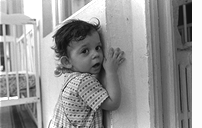 Speaking of a lack. In the thirteenth century, Frederick II, German King, King of Sicily and Emperor of the Holy Roman Empire, wanted to know what language children, if deprived of any verbal influence, would speak as they grew. He took a group of infants from their mothers and ordered they be raised by caretakers who provided food and shelter but were forbidden to speak in their presence. He never found out. None of the children in this bizarre experiment ever spoke a word, all having withered and died from lack of connection to the world they were born into.
Speaking of a lack. In the thirteenth century, Frederick II, German King, King of Sicily and Emperor of the Holy Roman Empire, wanted to know what language children, if deprived of any verbal influence, would speak as they grew. He took a group of infants from their mothers and ordered they be raised by caretakers who provided food and shelter but were forbidden to speak in their presence. He never found out. None of the children in this bizarre experiment ever spoke a word, all having withered and died from lack of connection to the world they were born into.
![]()
Sensory integration (SI) dysfunction, then, is a failure of the central nervous system. It keeps people from analyzing, organizing or connecting sensory messages — and from behaving in an organized or rational way. As children grow, this dysfunction directly affects cognitive thinking and emotional maturity.
An unusually high or low level of activity, impulsiveness, distractibility, high frustration and self-regulation problems are a direct result of early years of deprivation. It’s not that these children won’t cooperate, it’s that they can’t.
Each fair-weather day at the Romanian orphanage the children spend several hours in the maze of hidden dangers they call the yard. Sheets of jagged aluminum wrapped around old pipes hang at face level, large holes dug for incomprehensible reasons wait to swallow unsuspecting toddlers. Bits of broken glass lie like land mines, rocks and cracked concrete and sticks become chew toys for little ones not properly supervised. Yet the staff, for the most part, seems unconcerned, even though the toddlers in this yard have, effectively, 54 brothers and sisters. Ten or more 2-year-olds per caregiver.
The crying eventually becomes white noise. Always someone. One little dark-haired fellow, close to age 3, spends his days terrorized by two other boys. Each toy he picks up immediately becomes the property of another. With a screech of anger, the bullied boy throws himself to the ground, over and over again, screaming to the sky. The caregiver glances that way but never sees the incident so ignores them both. Neither the screamer nor the bully are given guidance. So the game continues unabated all day.
![]()
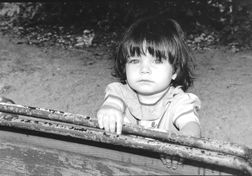 A small toddler in a bright dress and a foul-smelling diaper sat on the ridge of a former ditch in the hot sun for two hours, rocking, occasionally putting some dirt in her mouth. No one bullied her. No one spoke to her. She made no noise. When outside time ended, she was pulled to her feet by the arm, called by name by a friendly voice and walked back into the building. She would soon be changed and washed up, fed and placed in her bed or on the floor. She has shelter, food, clothing.
A small toddler in a bright dress and a foul-smelling diaper sat on the ridge of a former ditch in the hot sun for two hours, rocking, occasionally putting some dirt in her mouth. No one bullied her. No one spoke to her. She made no noise. When outside time ended, she was pulled to her feet by the arm, called by name by a friendly voice and walked back into the building. She would soon be changed and washed up, fed and placed in her bed or on the floor. She has shelter, food, clothing.
Attachment disorder is a physical and emotional impairment that short circuits a child’s ability to connect with others. They cannot return love because loving behaviors are associated with fear or pain because of prior abuse and neglect. The inability to trust manifests itself in many forms: severe control issues, manipulative and oppositional behaviors, dislike of praise or gifts and behaviors that sabotage close relationships.
This is not just an emotional need, it is a physical dysfunction, said Lyda Simmons, PhD ’82, a North Richland Hills therapist who specializes in sensory and attachment disorders.
“These children’s brains are altered from the abuse and neglect,” she said. “And the first step to helping them is admitting that there is a neurological problem.”
Newborn brains contain masses of neurons that must connect as the child grows. After birth, the brain begins a natural pruning process — what is used remains, what’s unused is trimmed. If there’s no touch, taste, voice or mimicking, many necessary connections are trimmed.
Children with severe attachment disabilities are on a sure trajectory for sociopathic behaviors — antisocial activities, mental illness, suicide and juvenile and criminal problems unless there is intervention, Purvis said. Many, like Dmitri, are already on anti-depressants or anti-psychotic drugs.
“Data indicates that these children behave like this because of the attachment disorder,” she said. “A child who has never been connected to anyone lacks moral development because it hinges on I care about you and don’t want to hurt you, while social development follows on You are responsive to me, I want to be responsive to others.”
![]()
| A touching moment. Karyn Purvis takes a moment with Dmitri and a fellow camper for a hug. | 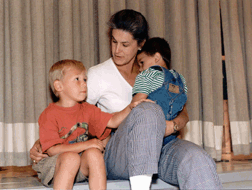 |
![]()
Children with attachment disorder develop strong survival behaviors though their normal cognitive development is usually markedly delayed, Purvis said. A large part of their energy goes toward self- preservation — Am I going to get some food? Are my needs going to be met? Is anyone going to take care of me?
They appear mystically charming to most of the world but are setting the cat on fire or terrorizing their siblings at home. There is a core group of traits — stealing, lying about the obvious, cruelty and food issues. The children appear to connect to everybody, but it’s all superficial, manipulative.
These are not malicious behaviors, they are survival skills. These children just are not attached.
The Whites were told Dmitri was a house favorite. More likely they just wanted to get rid of him. People always want to get rid of the bully.
Even with his limited experience, Dmitri knew something was going to change in his life, he was leaving, whatever that meant. When it was time to go, the workers told him to say good-bye to the others. He refused, but they insisted and sent him into a room of children. Like the parting of the Red Sea, the children scattered as he strode into the mass, shoving some and heading for one boy. A quick hug to the only one he believed deserved this sentiment and Dmitri turned and walked toward the Whites. He never looked back.
Carol watched her new son and thought, “This kid’s a survivor. This is how he’s made it through this.”
And Mike’s thoughts?
“Uh, oh.”
Children raised in institutions seem to develop a remarkable capacity for figuring things out, putting things together, Purvis said, which translates to a remarkable ability for lying and stealing and manipulating other people. And though some of these children test with a genius I.Q., they have horrific attention deficits and emotional and social deficits.
That sort of behavior was dominant in the children at Camp Celebration this summer, Purvis said. A joint project between the TCU psychology department, the Parent’s Network for Post-Institutionalized Children and the Child Study Center in Fort Worth, Camp Celebration was a pilot project, the first of its kind in the nation, designed to study and treat children with sensory and attachment disorders, primarily children from foreign orphanages.
![]()
| Finding safe haven. Camp Celebration provided an environment that allowed children damaged by early years of neglect and abuse to recover a sense of security and begin to heal. | 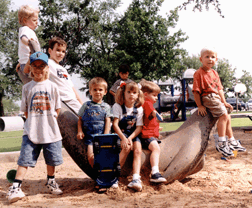 |
![]()
A lot of enthusiasm went into the planning, but even the optimistic Purvis said they didn’t expect a whole lot going in. What they found left them slack-jawed.
“We had three children who went into spontaneous regression; that is they went back to infantile behaviors that they missed or were denied in the orphanages,” she said. “It appears that what they got at camp allowed them to organize their thinking enough to regress to a time when they needed to bond to someone but couldn’t, but this time there was a loving parent at home and they connected.”
Marked, nearly miraculous advances in the children’s emotional and cognitive behaviors followed. Several moved from two-word to complex sentences, from total detachment from families to the beginnings of loving, trusting connections. Camp results were dramatic testimony of the resilence of these children’s minds and their ability to relearn, Purvis said.
Children who leave the orphanages before age 2 appear to have a better chance at adjustment. Longer than that and the brain continues to prune until the children develop a form of institutional retardation or autism.
“Some of those who were adopted at say, 7 or 8, present as retarded,” Purvis said. “You would see them and say they must have had some damage at birth.”
One boy at camp hoarded food and stole it from the other children even though there is an abundance in his life now. His parents had stocked his room with food, including a special kind of chocolate he used as a comfort food. It was his attachment substitute. Near the end of camp his mother reported that the boy brought her the chocolates and announced she could have them. He didn’t need them anymore.
He then lifted one from the box and placed it in her mouth. “The mother was in tears,” Purvis said. “This was so remarkable that he would offer her something, feed her something and touch her in the process.”
Until then, the cognitive aspect — I know I have enough food — was less powerful than the hunger that was built into his emotions.
One of the most startling discoveries for the camp researchers was the direct relationship between sensory input and attachment disorders.
“The importance of that is something no one has evaluated yet,” Purvis said. “But think about this, if I’m a mother of a newborn, within 15 minutes of birth he’s laid in my arms, feels my hands, my warmth, my touch, hears my voice, he sees my face, feels the vibrations of my voice and heart, tastes the milk.
“Attachment can be defined as a sensory experience. These children are born, swaddled in a tight blanket and laid in a crib and somebody props a bottle up every four hours a day for two years. As the child gets older the mush gets a little thicker and the hole in the bottle gets a little bigger.”
Purvis tears up at the thought.
“We took these children who have been in that kind of environment, where they missed the message of the first year — someone will take care of my needs — and put them in a sensory- and attachment-rich environment where they could pick that up.” Dmitri’s inability to bond to the Whites has had a chilling effect on the whole family.
“His attachment disorder keeps him from bonding to us,” Mike noted, “But whether he knows it or not, he’s kept us from bonding to him, it’s a two-way street.”
The problems reached critical just before camp. The Whites, emotionally bankrupt, were ready to give up on the disturbed little boy. Three weeks of camp not only gave them a chance to re-establish normality with the other two children, it somehow effected a marvelous change in Dmitri.
“He was saying one word, maybe two before, but something at camp really clicked in his brain, as if a pathway opened,” Carol said. “I wish I knew why, but his vocabulary exploded, he began to speak three- and five-word sentences, he began to articulate really complex issues, and he suddenly understood things he hadn’t had a clue about before.”
![]()
| Crash and Bump. The daily crash and bump activity was not only fun, it was critical sensory input for children starved for such stimulation. | 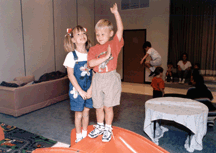 |
![]()
To build on the advances made at camp, the Whites are following the advice of Dmitri’s therapist and “belt-looping” mother and son. Belt-looping is a radical therapy proposed by Dr. Ronald Federici, an internationally recognized neuropsychologist and attachment expert. To facilitate bonding, Federici suggests the belt-looping, in effect keeping the child within several feet of a parent to control their environment 24 hours a day until bonding and healing begins. Carol has put her business up for sale to practice this therapy.
Carol said one of the biggest challenges has been to get the people around Dmitri to understand why their parenting seems so out of the ordinary.
“Nobody understands what attachment disorder really is,” she said. “It’s hard because he selects people to superficially warm up to, and they say he’s wonderful. We see it as manipulation and want to keep him away, but the family doesn’t see this, they say ‘We saw a normal kid, why are you acting this way?’ He’s able to separate the extended family from you, which you need very much for support.”
Psychology Prof. David Cross, who oversees the day camp and research, said they hoped for some minuscule changes in the campers and accepted that there might be none. They were completely unprepared for what they found.
“I interviewed six or eight of the families from the first group at the end, and it was really dramatic. In two of the cases, the parents completely broke down in tears of joy,” he said. “The impact on their family was monumental. And in two of those cases they had already started the paperwork to let those kids go.
“The question is not did something happen?” he said. “But Why did it happen?”
Effecting permanent change in children so damaged will take much longer than three weeks. But it is a start. The Whites feel guarded encouragement but admit they would never have brought problems like Dmitri’s into their family knowingly. Had they been better informed, they would have followed a different path.
Better information is one goal of legislation proposed by Sen. Jesse Helms. This fall, Federici presented data from Cross’ and Purvis’ research and the camp before a Senate subcommittee dealing with this issue.
An aide at Helms’ office said the bill would require all agencies dealing with foreign adoptions to be accredited. Part of the accreditation would require six weeks of pre-adoption training for all prospective parents, as well as follow-up support for the families.
TCU’s pioneering efforts in treatment will put it in a position to help with that training and support, Cross said.
“There are few really dramatic things in psychology, in terms of theory or interventions,” he said. “When drugs were discovered to treat schizophrenia or depression, that was big. One of the most recent was the treatment for autistic kids. That is a tremendous success story.
“I think this is going to be the next success story.”
Federici praised the camp program, acknowledging that it is a first-of-its-kind.
“It is a model of dealing with the very disturbed Eastern European child,” he said. ” Actually, I think the camp program should serve as a model for other intensive treatment programs for these children, as so many families waste their time and money in nonproductive therapies.”
The need is likely to become immense. Statistics show that of the children coming from overseas, one-third will adjust well, one-third will need some help and one-third may never recover. That means that more than 10,000 children will arrive in this country each year with at least some need for professional counseling and help.
Creating a consortium in Fort Worth that will provide service, training and reseach for post-institutionalized children and their familes is the ultimate goal, Cross said.
“TCU can’t do it all by ourselves, but we can facilitate the process,” he said. “This is an area that has a lot of exciting potential, and TCU has a lot of resources — the School of Education, Miller Speech and Hearing, Harris School of Nursing and the Starpoint School.
“We’re going to make it happen one way or another.
Life with Dmitri will continue to be a challenge, the Whites know that. They glean as much pleasure as they can from the small advances and try to imagine a better day. But they won’t give up.
![]()
| Happier days. The Whites after camp: Lauren, Mike, Dmitri, Carol and Chris. | 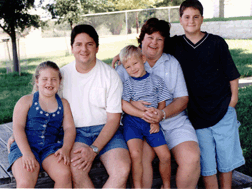 |
![]()
“He’s here and I will work with him until my dying day,” Carol said. “In my heart, he is my child. I could have had a birth child with a problem. He’s disabled, you just can’t see his disability.
“He’s here, he’s in this family, and he’s staying.”
![]()
A celebrated camp
Camp Celebration, the brain-child of Karyn Purvis and Dr. David Cross of the TCU psychology department and Kathie Seidel, chapter president of the Texas Parent’s Network for Post-Institutionalized Children, was held at the Child Study Center in Fort Worth during two three-week periods in June and July. Daily activities incorporated intensive sensory stimulation and a concentrated focus on attachment behaviors. Ten 4- to 8-year-olds attended the first session, ten 10- to 16-year-olds comprised the second session.
As expected, younger children showed more marked results, though behavioral changes were also noted in the older group.
Preliminary camp data reflects an average 31.1 percent decrease in attachment deficit behaviors at the end of the camp. The children ages 4 to 8 showed an average 41.2 percent decrease; the children 10 to 13 showed an average 21 percent decrease. Overall, the children also showed a 19 percent increase in positive attachment behaviors. Each of the camp counselors — TCU graduate and undergraduate students — attended three days of training by nationally recognized experts in the field of sensory and attachment disorders.
Planning for next summer’s camp has already begun, and lessons learned this year will be incorporated into the new curriculum and training. Purvis and Cross hope to obtain grant monies that would allow expansion of the camps, eventually developing the program into a comprehensive center for training, treatment and research.

Your comments are welcome
Comments
Related Reading:
Features
Infographic: Minors
A wide variety of minors gives TCU students the chance to add depth to their majors or dive into new areas.
Features
Venture Capitalism 101
MBA students connect investors and startups in a Neeley program.